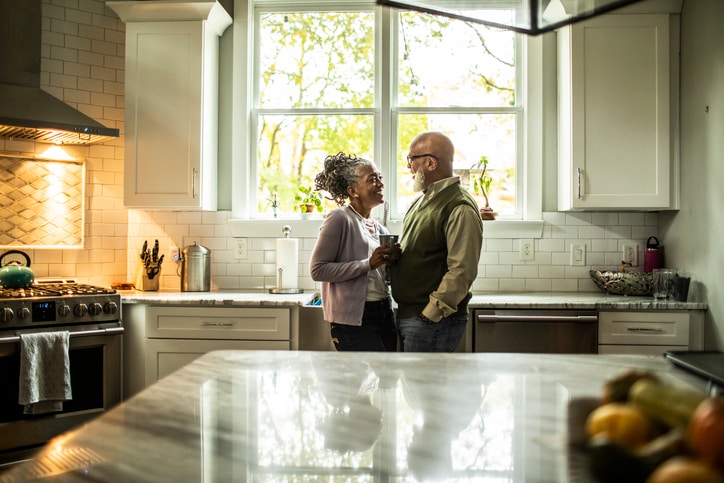If you’re just beginning to dip your toe into the world of senior caregiving, there are several acronyms you’ll find pop up frequently — CCRC being just one example. So what does it stand for? A CCRC is a Continuing Care Retirement Community, which is essentially a residential hamlet for those whose healthcare and lifestyle needs continue to change as they age.
Seniors may consider a move to a CCRC because they want the reassurance of knowing there’s help and assistance nearby while also allowing them to live a relatively independent life for as long as their health and energy level allows. At a CCRC, residents can up their level of care as their needs grow.
When narrowing in on where to live as one ages, Allie Mazza, owner of Brandywine Concierge Senior Services, a company that provides assistance with community placement assistance and family coaching in Chester County, Pennsylvania, encourages families to hone in on three things that are of top importance to them.
“It may be the ability for a married couple to age in place together,” Mazza says. “It may be proximity to family, amenities, cost, etc. Then, I tell them to build questions around those factors. Too often I see families worried about metrics or details from a questionnaire they found online, and it isn’t getting at the real meat of what they need to take away from a visit.”
We asked Mazza and other senior care experts to share the questions they think are most valuable when searching for a CCRC that best suits the needs and wants of your loved one. Their practical and compassionate wisdom will help make the best choice clear.
1. Does my loved one want to live near their current location?
Moving an aging parent to a new home that’s close to the residence they are leaving can make the transition to a CCRC more seamless. By staying local, they may still be able to attend their church, shop stores they know well, etc.
“On a personal and professional level, I’ve seen the impact that a move to an unfamiliar place can cause for a person with cognitive impairments such as dementia or Alzheimer’s disease, and it’s ill-advised for a number of reasons,” says Kristi Stalder, author of “Navigating Assisted Living: The Transition into Senior Living.” “When a cognitively impaired resident moves into a CCRC, it’s common to expect a 30-day decline in their decision-making abilities, as the resident experiences increased confusion. This behavior is usually redirected by encouraging social interaction with other residents during mealtimes and activities, but it can be challenging for those who are less inclined to participate or socialize. Once a new routine is established and our loved one settles into the new environment, they’re back to their baseline and thriving.”
Although there may be both short- and long-term effects of moving to a new area, it can still work. If family dynamics, finances or health issues make it impossible for them to remain close to their former home, Stalder encourages caregivers to explain the reasoning behind the move and encourage a loved one to choose a CCRC where they can live comfortably.
2. Is my loved one free to take trips and have visitors?
Ensuring that you and other family members can easily visit your loved one is key. Not only is it mutually beneficial — a 2016 study out of Boston College found that a close relationship between grandchildren and grandparents reduces the risk of depression in both — but there could be a late-night call, in which the family has to come to the facility, says James Simasko, an elder law attorney with Simasko Law in Mount Clemens, Michigan. For this reason, it may be important to choose a community that has a welcoming, flexible approach to visitors.
3. How social is the community? What is the activity calendar like?
Learn about any excursions the community plans for residents to ensure your loved one maintains an engaging social life. To get a genuine feel for how active the community is, Suzanne Asaff Blankenship, author of “How to Take Care of Old People Without Losing Your Marbles,” recommends visiting the grounds at odd times, like early morning, evening and weekends.
“Observe what is going on and how well-staffed the community is at these times,” she says. “Are there activities going on? Are the residents out of their residences and engaged on the weekends? Is there security after office hours? Is there a receptionist available to greet visitors? What is the level of nursing staff or aides during the night and weekends?”
4. What are the other residents like?
“It’s important to place a loved one where the residents are close in age and have some of the same interests,” says Simasko. “You don’t want to place an active 82-year-old with a bunch of fellow residents in their late 90s.”
For this reason, ask if there are activities geared toward your loved one’s current age or enough peers who can keep up with their overall energy level. While CCRCs will include seniors of all ages, it’s reassuring to know that your family member won’t be the odd one out or grow bored easily.
Simasko suggests assessing your loved one’s overall energy level and whether or not they are more or less inclined to be social, then compare it with the vibe of the CCRC.
5. What happens when more advanced care is required?
Erin K., of New York City, has been working on finding a CCRC for her parents that can best accommodate the growing needs of her 74-year-old mom who was diagnosed with dementia five years ago.
“The key consideration for our situation is access to care — both part-time help and on-site doctors and nurses, and access to appointments off of the property,” she says. “My mom’s health is declining to the point where my father is not going to be able to shoulder all of the responsibilities for her care. We need to make sure the community in which they live can take that stress away from him and give her the attention she needs.”
Simasko agrees that this should be a priority question for all caregivers and potential residents of a CCRC. He suggests asking: “What if my loved one gets worse? Can the facility handle that or will they have to move?”
“You should also talk to the other residents and their family members to get their opinion of the place and how their health is being managed,” he says.
6. Are the grounds and buildings well-kept?
“Be observant of the little details within the CCRC, such as the condition of the building,” says Stalder.
The way cleanliness is maintained at a CCRC is crucial, as germs and viruses can spread quickly in senior living facilities, he says. To account for this, he advises families ask themselves the following when visiting a CCRC:
-
Do the carpets appear to be clean?
-
Is there an odor throughout the common areas and hallways?
-
Are the staff friendly and welcoming?
-
Do the residents appear to be happy?
“It’s critical that each community has a building maintenance team that manages the cleanliness and sanitation of common area surfaces, handrails, doorknobs and flooring,” says Stalder. “Odors, soiled carpets and dirty rooms are an indication of poor maintenance and substandard maintenance is a big red flag.”
7. What type of training does the staff receive to appropriately handle any issues that may arise concerning my loved one and their health?
Mazza suggests focusing on what kind of ongoing training the company provides their employees and how the associates are rewarded, promoted and developed.
“Ask to meet a team member from the frontline, and ask about their experience working for the company,” Mazza says.
As with any job, an employee should grow and evolve over time. Fostering continuing education in the area of senior care for their staff is an admirable quality in a CCRC because it shows they have the best interests of both residents and employees in mind.
8. Is the CCRC affordable in the long run?
Potential residents’ families need to consider the cost of a CCRC in the long-term, with the hope being that their aging relative has many wonderful years ahead of them.
Erin K. says that in her search for a CCRC, pricing has been her main concern.
“When you are moving in at a point where the person could live there for 15 years, the money can run out fast,” she says.
Another potential issue, according to Simasko, is the nickel-and-diming of costs with care levels. He encourages his clients to inquire about a bundled payment plan, in which the resident makes a single payment that covers a variety of healthcare services. These are typically considered value-based agreements and offer a lower financial risk than other types of payment plans, like those in which you pay for different services separately.
You’ll also do well to ask what determines different levels of care and the determining factors for when a senior might need to move to additional care, Simasko says. For example, if your loved one suddenly requires more physical therapy or can no longer perform specific tasks on their own anymore, it may necessitate a change in either their healthcare plan within the CCRC or a move to a facility better equipped to handle their changing needs.
Final advice
Armed with these questions, you can make an informed decision that will hopefully achieve a comfortable and caring environment for you or your loved one.
In the end, Mazza says, go with your gut.
“Regardless of where you go, it will be an adjustment,” she says. “It’s up to the individual and/or the family to weigh the importance of maintaining doctors and local resources, as well as friendships and connections. Follow these priorities, and you can’t go wrong.”





